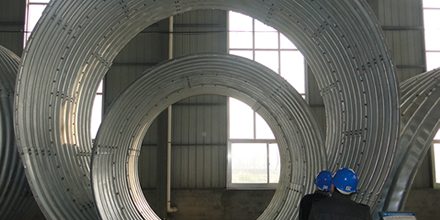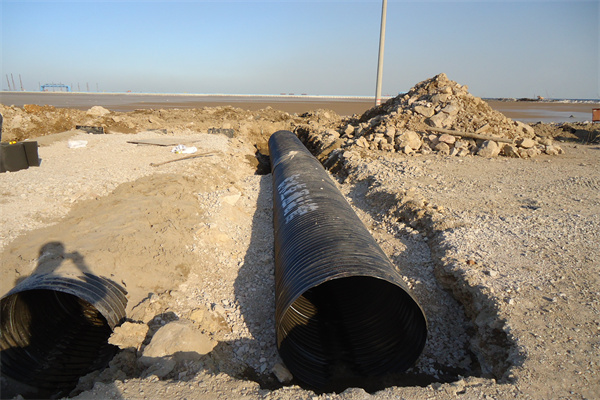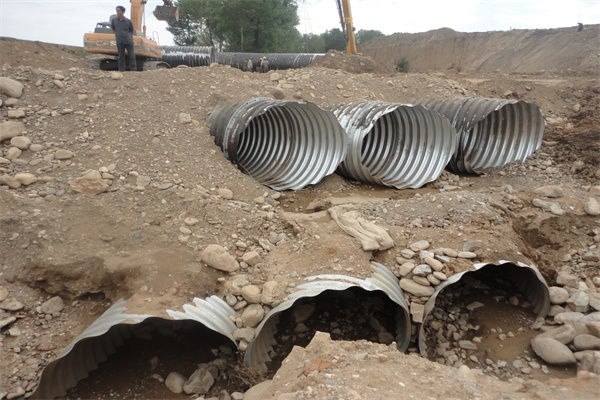Technology Of Corrugated Pipe Culvert Foundation
1) Construction process flow corrugated pipe culvert
The process flow is as follows: preparation before construction → construction layout → excavation of culvert foundation pit → leveling of the site → layered backfilling of the foundation → detection of compaction degree, moisture content, etc. → leveling measurement → leveling of the site → construction layout → assembly of pipe sections → detection of water tightness and longitudinal slope of the pipe bottom - detection and remediation of anti-corrosion coating - positioning of the culvert pipe → layered backfilling on both sides → detection of compaction degree, moisture content, etc. → layered backfilling of the pipe top → detection of compaction degree, moisture content, etc. → inlet and outlet treatment.
2) Foundation Part 1: Excavation and Filling of Foundation Pit
1. The excavation of the foundation pit should be carried out with the proposed steel corrugated pipe culvert having a width three times that of the steel corrugated pipe culvert. If the construction site is too small, at least a working space of 1.5m or more beyond the span should be ensured. This is not only convenient for assembly, but also conducive to backfilling and compaction around the steel corrugated pipe culvert.
2. The foundation should maintain a uniform bearing capacity for the entire steel corrugated pipe culvert. To avoid the intersection of soft and rock foundations, if it is unavoidable, high-quality sand and gravel should be compacted and formed. After excavating the rock foundation, it should be replaced with gravel with a thickness of at least 30cm to minimize the settlement of the entire culvert.
3. The thickness of the foundation should be around 30-80cm from the bottom of the steel corrugated pipe culvert, and it should be formed using sandy soil, gravel or crushed stone soil with good permeability and particle size distribution, with a density that meets the design requirements. The maximum particle size of the material shall not exceed 1/2 of the wavelength or 50mm.
4. A coarse sand cushion layer with a thickness of 7-15cm and a maximum particle size of 12mm should be laid in the contact area with the corrugated steel plate.
3) Foundation section - excavation and filling of foundation pit
For culverts with relatively long lengths and high fill, a pre camber of 3-6% should be reserved on the foundation. The corrugated pipe buried on a general soil foundation often experiences certain subsidence after a period of time, and it is often larger in the middle than at both ends of the pipeline. Therefore, the pipe body of the corrugated pipe laid under the embankment should have a reserved arch. Its size is determined by factors such as the possible settlement of the foundation soil, the longitudinal slope of the culvert bottom, and the height of the fill soil. It can usually be 0.3% to 1% of the pipe length, and should not exceed 2% at most to ensure that there are no depressions or landslides in the middle of the pipeline. As shown in the picture.
4) Basic section - Treatment methods for various foundation soils
Treatment methods for various foundation soils
1. High quality land foundation, Unscreened sand, crushed stone, gravel soil, and sandy soil are ideal foundation materials, but hard objects such as stones with a diameter of more than 10cm need to be removed.
2. General soil foundation, Ordinary foundations with low bearing capacity require a certain thickness of foundation. However, if the undisturbed soil of the culvert bottom trench is strictly compacted (with a compaction degree of over 90% of the heavy compaction degree), the corrugated pipe can also be directly placed on the foundation.
3. Rock foundation,Corrugated pipes cannot be directly placed on rock or concrete foundations, as overly rigid supports not only reduce the good flexibility of the pipe wall itself, but also decrease the load-bearing capacity of the culvert pipe. So for rock foundations, a part of the soft rock should be excavated and replaced with a layer of high-quality soil. Generally, the replacement thickness should not be less than 30cm, and it should be carefully compacted. When excavating soft rock trenches, high explosives and deep hole blasting should not be used to avoid loosening too much of the outer layer. The weathered rock layer foundation cannot be used as a foundation and needs to be replaced with high-quality soil of 3D width.
5),Basic section - Treatment methods for various foundation soils
1. Soft soil foundation such as karst terrain and silt river foundation When constructing corrugated pipe culverts based on its terrain characteristics, special treatments are used to increase the overall integrity of the foundation and make its settlement basically consistent. Generally, a certain thickness of soft soil or silt is removed first, and the removal thickness is determined by the depth of the soft soil. After removing the soft soil, the method of throwing stones is adopted. When the stone throwing foundation has a certain bearing capacity, a 20-30T roller is used to compact it. The thickness of the stone throwing is generally 150-300cm. After the stone throwing foundation is stabilized. Method 1: On top of it, replace with 80-120cm gravel or crushed stone foundation, layer by layer and compact. (To reduce post construction settlement, two two-way geogrids can also be set 50cm and 100cm below the surface of the gravel or crushed stone foundation, with a length and the length of the culvert, and a width generally (2 * 3m+aperture).) Lay a 7-15cm gravel leveling layer on the top of the foundation. Method 2: After stone throwing and compaction, pour 50-100cm of C20 concrete on top of it.
2. Collapsible loess foundation,Due to the special nature of the soil in collapsible loess, after excavation of the foundation pit, the backfilling of the base should not be less than A 100cm layer of rubble concrete (or 3:7 layer of white lime soil) is backfilled with a high-quality sand and gravel cushion layer with a thickness of 30-80cm.
 Products
Products Application
Application



